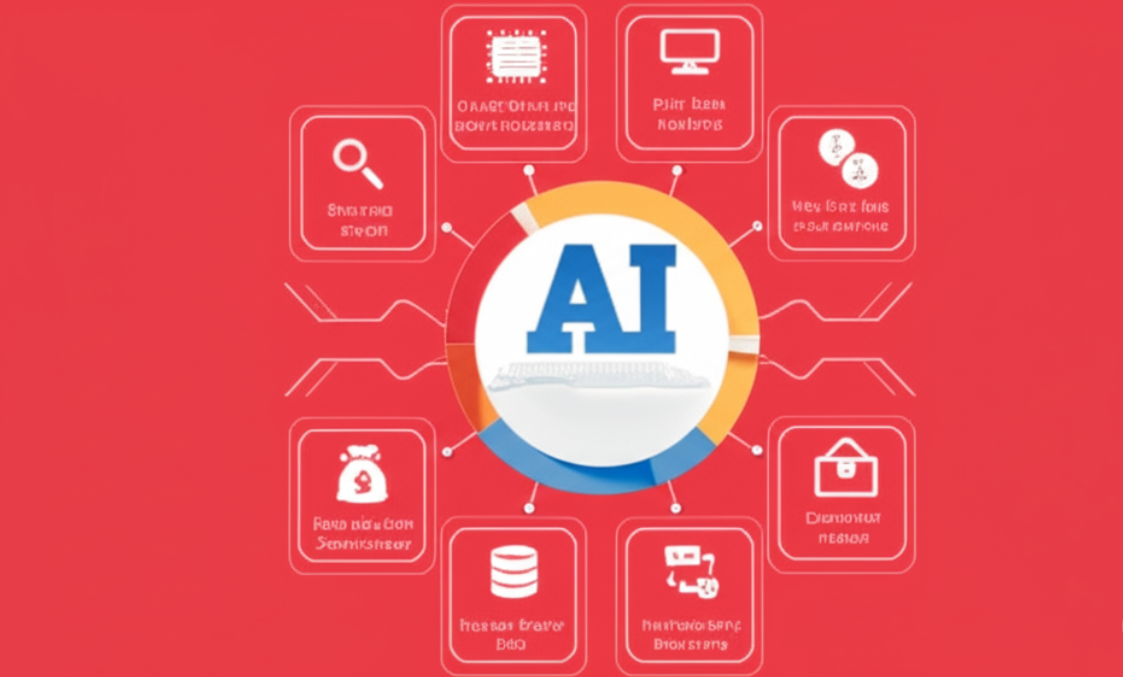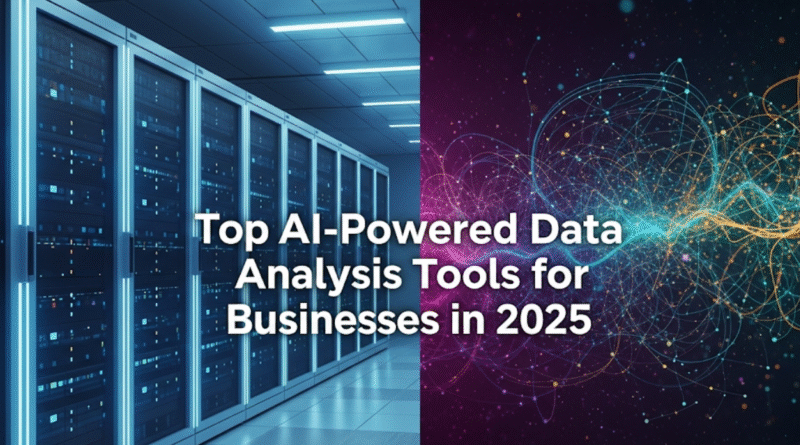Top AI-Powered Data Analysis Tools for Businesses in 2025
We are all looking for gold and data is gold, while businesses that can find it cost effectively and mine it — get rich. Five years from now, in 2025: Artificial intelligence has changed the way information is analyzed by companies and turned complex data tasks into quick and easy ones. Small start-up but want to take on the corporate giants? Get AI powered tools and grab profits!
This guide focuses on the top AI data analysis tools available today, and which tools work best for specific business needs or budgets. This document will spell out their features, costs, and practical use cases to help you find the right tool for your business.
The Trends Making AI Data Analysis Tools Essential
Conventional data analysis used to require weeks, or months. Teams would come in hordes, running through numerous iterations of spreadsheets and reporting from one or more BI tools. Nowadays, similar work is done by AI tools in minutes or hours.
AI data analysis tools are game-changers for all the following reasons:
- Lightning fast: Analyze millions of data points within seconds
- Accuracy: Decreasing human mistakes in computation and forecasting
- Insights: Find patterns humans miss
- Automation: You can run multiple reports automatically without any manual intervention
- Scalability: The ability to deal with increasing data volume
AI data analysis tools have shown 15–20% better decision-making accuracy and analytics times to insights that are 40% faster than traditional methods.
Essential Features to Look For
How to choose a great AI Data Analytics platform before reviewing the top analytics tools:
Core Capabilities
- Natural Language Processing: Write in plain spoken English and ask questions
- Automated Insights: Unprompted recommendations
- Data Visualization: Generate charts and graphs automatically
- Predictive Modeling: Trend and outcomes prediction
- Real-time Processing: Process data as it comes in
Integration Options
- Database Connections: Integration with SQL, NoSQL and cloud-based databases
- File Imports: Import from Excel, CSV, JSON and more
- API Access: Integration with business software
- Cloud Compatible: Works with AWS, Google Cloud, Azure
User Experience
- Drag-and-Drop Interface: No coding required
- Dashboard Customization: All views should be tailored to your needs
- Collaboration Tools: Communication of insights across the board
- Mobile Access: Analysis on phones & tablets
Best AI Data Analysis Tools of 2025
Tableau with Einstein Analytics
Ideal For: Large enterprises who require comprehensive visualization capabilities
When it comes to data visualization, Tableau is still the gold standard, and integrating AI with Einstein Analytics takes this tool to another level of excellence. The system employs machine learning to recommend visualizations and indicate important patterns within data.
Key Features:
- Intelligent cleansing of datasets
- Machine learning for pattern discovery across data sources
- Natural language queries (e.g., “Show me sales trends”)
- Visualizations with forecasting models
- Enterprise-grade security and governance
Pricing: From $75 per month per user for Tableau Creator
Pros:
- Industry-leading visualization capabilities
- Good community and learning resources
- Handles massive datasets efficiently
- Great integration with other business tools
Cons:
- Steep learning curve for beginners
- Higher cost compared to alternatives
- Requires significant setup time
Microsoft Power BI with AI Capabilities
Ideal For: Organizations utilizing Microsoft Office Suite
Power BI has now become an end-to-end AI-powered analytics platform tightly integrated with the Microsoft ecosystem. The tool provides some of the best AI functionality compared to other tools.
Key Features:
- Natural language for simple Q&A
- Auto-generate insights from datasets
- Machine learning integration with Azure
- Real-time dashboard updates
- Data auto-refresh from multiple sources
Pricing: Starting at $10 per user per month
Pros:
- Excellent value for money
- Deep integration with Excel and Microsoft tools
- User-friendly interface
- Strong mobile app functionality
Cons:
- Limited customization compared to Tableau
- Cannot handle very large datasets as well
- Fewer advanced statistical features
DataRobot
Ideal For: Companies focused on machine learning and predictive analytics
DataRobot makes advanced analytics approachable by automating the entire process, helping users with a business background leverage machine learning. This is especially powerful when you work for a company that needs to deploy predictive models rapidly.
Key Features:
- Automated machine learning model building
- Time series forecasting
- Feature engineering automation
- Model explanation and interpretation tools
- Deployment and monitoring capabilities
Pricing: Contact for custom quote based on usage and features
Pros:
- Complex models can be built without coding
- Excellent model accuracy and performance
- Comprehensive model management features
- Comprehensive support for data types
Cons:
- Expensive for smaller companies
- Limited data visualization capabilities
- Requires training to use effectively
Sisense Fusion
Ideal For: Medium-sized firms requiring simple AI analytics
Sisense is the perfect solution for businesses that require extensive analytic power without complex features. Their Fusion platform works with AI taking care of automation.
Key Features:
- Smart data models for complex relationships
- Automated anomaly detection
- Natural language generation for insights
- Embedded analytics for custom applications
- Multi-source data integration
Pricing: Begins at $2,000/month for small groups
Pros:
- Very user-friendly interface
- Fast implementation time
- Good performance with large datasets
- Excellent customer support
Cons:
- Limited advanced statistical functions
- Fewer customization options
- Cost per user isn’t competitive for large teams
IBM Watson Analytics (Cognos Analytics)
Ideal For: Large enterprises requiring complex data governance
AI-based analytics platform from IBM with enterprise-level capabilities by combining IBM Watson AI. Built for entities that require strong security, governance and compliance capabilities.
Key Features:
- Advanced natural language processing
- Automated data preparation and modeling
- Smart visualization recommendations
- Enterprise security and governance
- Built on IBM’s wider AI ecosystem
Pricing: Starting at $25 per user per month
Pros:
- Strong enterprise features
- Excellent AI-driven insights
- Robust security and compliance tools
- Well integrated with existing IBM technologies
Cons:
- Complex setup and configuration
- Performance issues with some data types
- Requires technical specialists to extract maximum value
Qlik Sense with Insight Advisor
Ideal For: Businesses that require user-friendly self-service analytics
Qlik Sense offers a straightforward, AI-assisted way to ask questions and create visualizations with its associative model. It’s great for companies with multiple stakeholders in analytics.
Key Features:
- Associative data model for free exploration
- AI-generated insights and suggestions
- Natural language interaction
- Advanced geospatial analytics
- Mobile-optimized interface
Pricing: $30/month per user or more
Pros:
- Unique associative analytics approach
- Strong self-service capabilities
- Good mobile experience
- Flexible deployment options
Cons:
- Learning curve for associative model
- Limited statistical functions
- Can be cost prohibitive at scale
Google Cloud AutoML and Looker
Ideal For: Tech-savvy businesses already leveraging Google Cloud
Google’s proposition of AutoML + Looker provides a powerful combination of automated machine learning and business intelligence. Well-suited for companies comfortable with cloud-native solutions.
Key Features:
- Automated machine learning model creation
- Real-time data processing
- Integration with Google Cloud services
- Advanced visualization capabilities
- Collaborative analytics workflows
Pricing: Pay-per-use model
Pros:
- Excellent scalability
- Strong integration with Google services
- Advanced machine learning capabilities
- Good value for high-volume usage
Cons:
- Requires Google Cloud knowledge
- Complex pricing structure
- Limited support for non-technical users
Alteryx with Intelligence Suite
Ideal For: Organizations requiring advanced data preparation
Alteryx Intelligence Suite introduces AI functionalities beyond automated insights and machine learning, using the power of their data preparation and blending capabilities. Ideal for organizations working with semi-structured or unstructured data.
Key Features:
- Advanced data preparation and blending
- Automated machine learning workflows
- Text and image analytics
- Spatial and location intelligence
- Process automation capabilities
Pricing: From $5,195/year per user
Pros:
- Excellent data preparation capabilities
- Strong workflow automation
- Good for complex analytical projects
- Comprehensive training resources
Cons:
- Expensive licensing costs
- Steep learning curve
- Resource-intensive software

Comparative Study: AI Data Analysis Tools
| Tool | Ideal For | Starting Price | AI Strength | Ease of Use | Enterprise Features |
|---|---|---|---|---|---|
| Tableau | Large enterprises | $75/month | Visualization AI | Medium | Excellent |
| Power BI | Microsoft users | $10/month | Natural language | High | Good |
| DataRobot | ML-focused companies | Custom | AutoML | Medium | Excellent |
| Sisense | Mid-sized businesses | $2,000/month | Smart modeling | High | Good |
| IBM Watson | Enterprise governance | $25/month | NLP insights | Low | Excellent |
| Qlik Sense | Self-service analytics | $30/month | Insight generation | Medium | Good |
| Google AutoML | Tech companies | Pay-per-use | ML automation | Low | Excellent |
| Alteryx | Data preparation | $5,195/year | Workflow AI | Low | Good |
How to Select the Best Tool for Your Business
Choosing the most effective AI data analytics tool for your organization depends on several factors unique to your business:
Consider Your Business Size
Small Businesses (1-50 employees)
- Prioritize usability and shorter setup times
- Consider Power BI or Google Data Studio
- Choose flat-rate pricing tools
- Prioritize integration with existing software
Medium Businesses (50-500 employees)
- Balance features with complexity
- Consider Sisense or Qlik Sense
- Look for good collaboration features
- Ensure scalability for growth
Large Enterprises (500+ employees)
- Prioritize security and governance
- Use established platforms (Tableau, IBM Watson, DataRobot)
- Look for enterprise support and training
- Plan for complex integration needs
Evaluate Your Technical Expertise
Non-Technical Users
- Choose tools with drag-and-drop interfaces
- Natural language query capabilities
- Prioritize automated insights and recommendations
- Tools providing elaborate training resources
Technical Teams
- Look for tools with advanced customizations
- Seek API access and integration options
- Machine learning and statistical features
- Custom development-friendly tools
Assess Your Data Complexity
Simple Data Sources
- Excel files, flat databases, web analytics
- Use Power BI or Google Data Studio
- Support for easy data import
- Focus on visualization and basic analysis
Complex Data Environments
- Multiple databases, real-time streams, unstructured data
- Consider Alteryx, DataRobot or enterprise solutions
- Look for advanced data preparation capabilities
- Ensure the tool can scale to your data volume
Implementation Best Practices
Here are the best practices to get the most out of your AI data analysis tool:
Phase 1: Preparation (Weeks 1-2)
- Define objectives: What questions are you trying to address?
- Data audit: Sources, quality issues, access requirements
- Team assessment: Training requirements and technical capability
- Success metrics: What are the measures of success for the tool?
Phase 2: Test Phase (Weeks 3-6)
- Start small: Pick a single department or use case
- Clean your data: Collect high-quality test datasets
- Train early adopters: Get in-house experts familiar with the tool
- Create templates: Build pre-configured dashboards for others to use
Phase 3: Rollout (Weeks 7-12)
- Scale gradually: More users, more data sources
- Setup governance: Rules for data access and sharing
- Create documentation: Build guides and best practices
- Monitor usage: Track adoption and challenges
Phase 4: Optimization (Ongoing)
- Collect feedback: Understand what users are experiencing
- Refine processes: Improve efficiency and accuracy of workflows
- Advanced training: Develop specialization in key areas
- Measure ROI: Track clear business value and impact
Common Pitfalls to Avoid
Most companies face challenges when implementing AI data analysis tools. Here are common errors and how to avoid them:
Data Quality Issues
- Issue: Poor quality results from poor data inputs
- Solution: Clean and filter data; maintain good data practices
Over-Complicated Start
- Issue: Users get overwhelmed with too many use cases
- Solution: Begin with simple use cases and increase complexity gradually
Lack of Training
- Issue: Users cannot properly utilize new features
- Solution: Provide proper training and continuous learning
Poor Change Management
- Issue: Teams resist adoption and stick to old methods
- Solution: Include users in selection, show clear value, and provide support
Inadequate Infrastructure
- Issue: Slow performance and intermittent failures
- Solution: Provide adequate computational resources and ensure reliable data connections
Future Trends in AI Data Analysis
The domain of AI-based data analysis is rapidly changing. These are the key trends directing the industry:
Conversational Analytics
Conversational AI tools that enable individuals to ask complex questions directly and get detailed answers with supportive visualizations.
Automated Insights
Tools that can identify important trends, anomalies and opportunities without any prompting, making insights more accessible to non-technical users.
Real-Time Decision Making
Integration with operational systems allows for real-time analysis and automated decisions, shrinking the time between knowing and doing.
Augmented Analytics
AI assistants guide users through analysis by suggesting questions, recommending chart types and translating complex results into plain language.
Embedded Intelligence
Analytics built directly into business applications, enabling users to access insights without switching between different tools.
Measuring Success and ROI
Benchmark key performance indicators to demonstrate return on investment for AI data analysis tools:
Efficiency Metrics
- Report creation time (before vs. after)
- Number of manual tasks automated
- Reduction in data preparation time
- Faster decision-making cycles
Quality Metrics
- Accuracy of predictions and forecasts
- Reduction in data errors
- Consistency across different analyses
- User satisfaction scores
Business Impact Metrics
- Increase in revenue due to data insights
- Cost savings from operational improvements
- Customer satisfaction improvements
- Competitive advantages gained
User Adoption Metrics
- Number of active users
- Frequency of tool usage
- Range of use cases implemented
- Self-service analytics adoption
Frequently Asked Questions
Q: What should a small business expect to spend on AI data analysis tools? A: $50-200 per month per user for most tools. Begin with a basic plan and scale according to your needs. Consider training costs and potential consulting costs for setup.
Q: Are these tools only effective if I have a data scientist on my team? A: Not necessarily. Many AI data analysis tools are now designed for business users and are easier to use. However, having a skilled data analyst will help you make the most of advanced features.
Q: How long does it take to see results from implementing these tools? A: Companies generally see initial results within 4-8 weeks of implementation. However, it typically takes 3–6 months for teams to drive real business impact as they learn to use the tools and integrate insights into decision-making.
Q: Can these tools replace human analysts? A: AI tools augment rather than replace human analysts. They perform routine tasks and identify patterns, but strategic thinking and high-level problem analysis still depend on human interpretation within a business context.
Q: What are the most common mistakes companies make when selecting data analysis tools? A: The biggest mistakes are choosing tools that don’t match the team’s technical capabilities and failing to set clear, attainable objectives. Poor change management is also a common issue.
Q: How do I ensure data security with cloud-based AI tools? A: Look for data encryption, access controls, audit trails and compliance certifications. Understand where your data is stored and who can access it.
Q: Should I choose a specialized tool or an all-in-one platform? A: It depends on your needs. All-in-one platforms offer convenience and integration but may not provide best-of-breed capabilities in specific areas. Specialized tools offer advanced features but require more work for integration. Consider your technical resources and requirements.
Q: When should I consider switching tools? A: Evaluate your tools annually, but don’t change frequently. Consider major changes when current tools aren’t meeting your needs or significantly better options appear. Factor in switching costs and learning curves.
Conclusion
AI data analysis tools have become essential for competitive businesses. They can transform how your company makes decisions, identifies opportunities and manages risks.
Choose a tool that matches your current capabilities while providing room for growth. Set clear goals, focus on training and education, and create a data-driven culture within your organization.
Whether you’re a small business owner trying to understand customer behavior or a large enterprise streamlining complex operations, the right AI data analysis tool can provide significant advantages.
Implementing AI data analysis tools is a journey, not a destination. Start small, learn from experience, and scale gradually. With the right approach and tools, you can make smarter decisions faster and achieve tangible business results.
Companies that can convert information into insights quickly and accurately will be tomorrow’s winners. Choose the right AI data analysis tool and start that transformation today.

